The Hampden-Sydney experience is enriched by opportunities to conduct and share original research, helping students develop essential skills. Through the Office of Undergraduate Research and Creative Activity, students regularly conduct research, collaborate with faculty, and present their work in diverse ways, including at off-campus locations. 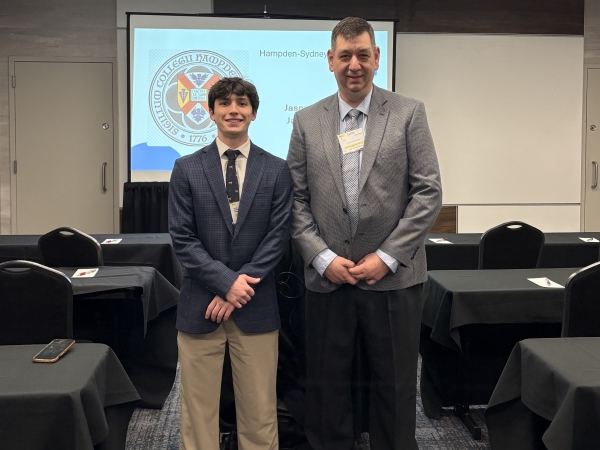 This past spring, several students, accompanied by faculty advisors, traveled to academic conferences to present their original research and engage with leading experts and fellow scholars from across the country.
This past spring, several students, accompanied by faculty advisors, traveled to academic conferences to present their original research and engage with leading experts and fellow scholars from across the country.
In mid-March, Assistant Professor of Economics and Business Jason Matyus and Jacob Crabtree ’25 made their way to the Southwest Decision Sciences Institute (SWDSI) annual meeting in Tulsa, Oklahoma.
During the 2024–2025 academic year, Dr. Matyus and Jacob collaborated on an academic article titled “Factors That Contribute to Firm Profitability in the Retail Industry.” The piece, which Jacob presented at the conference, features a regression analysis of data exploring the relationship between profitability factors and the strategic planning of retail businesses. The article is currently under review for publication in the Journal of Behavior and Applied Management.
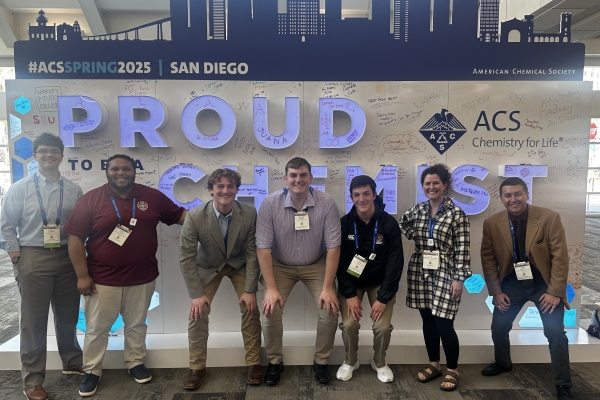 In the days following, Assistant Professor of Chemistry Glenn Gilyot and Assistant Professor of Chemistry Ava Kreider-Mueller, along with Jackson Cofer ’27, Ben Gerber ’27, Charlie Redding ’27, Evan Old ’26, and Marc Moroz ’26, headed to San Diego for the American Chemical Society (ACS) national meeting.
In the days following, Assistant Professor of Chemistry Glenn Gilyot and Assistant Professor of Chemistry Ava Kreider-Mueller, along with Jackson Cofer ’27, Ben Gerber ’27, Charlie Redding ’27, Evan Old ’26, and Marc Moroz ’26, headed to San Diego for the American Chemical Society (ACS) national meeting.
Jackson, Benjamin, and Charles presented posters at the undergraduate research poster session on March 24. Jackson’s project, “Investigating the binding of essential and non-essential metals to a series of common plant secondary metabolites,” was supervised by Dr. Kreider-Mueller. Benjamin’s project, “Development of a near-infrared naphthalimide-based fluorogenic probe for detection of leucine aminopeptidase,” and Charles’s project, “Small molecule fluorogenic probe for visualization of fluorophore-protein interactions,” were both supervised by Dr. Gilyot. On March 25, Evan gave an oral presentation at the Coordination Chemistry: Catalysis and Applications symposium titled “Comparison of the bonding motifs in a series of alkali metal-gallate and syringate complexes,” based on research with Dr. Kreider-Mueller. That same day, Marc presented a poster at the division of physical chemistry session, showcasing research that he completed with Dr. Andrey Vilesov at the University of Southern California during summer 2024. His project, “Infrared spectroscopy of ethanium cations in helium nanodroplets,” earned him the Outstanding Student Poster Award for Exemplary Research.
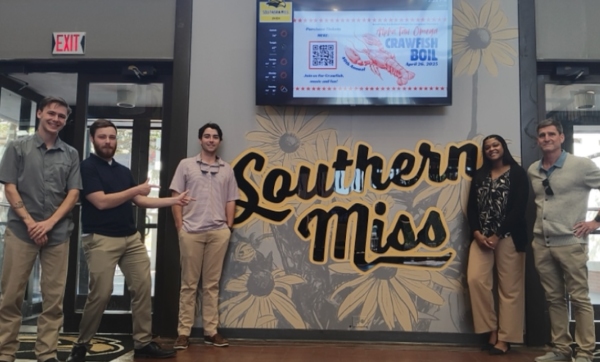 In mid-April, Assistant Professor of Rhetoric and Director of the Rhetoric Studio Miranda Rouse, Senior Lecturer in Rhetoric and Associate Director of the Rhetoric Program Shawn Schooling, Haden VonCanon ’27, Jacob Wilson ’27, and Jackson Martin ’26 attended the Excellence at the Center Conference hosted by the National Association for Communication Center (NACC) at The University of Southern Mississippi in Hattiesburg, Mississippi.
In mid-April, Assistant Professor of Rhetoric and Director of the Rhetoric Studio Miranda Rouse, Senior Lecturer in Rhetoric and Associate Director of the Rhetoric Program Shawn Schooling, Haden VonCanon ’27, Jacob Wilson ’27, and Jackson Martin ’26 attended the Excellence at the Center Conference hosted by the National Association for Communication Center (NACC) at The University of Southern Mississippi in Hattiesburg, Mississippi.
As current consultants in the Rhetoric Studio, all three students were engaged in the conference. Jackson participated in the panel “Elevating Communication Excellence: The Benefits of Teaching Writing and Speaking Together,” and Dr. Schooling contributed to the panel discussion “Understanding Students With ADHD,” while Dr. Rouse led and participated in several sessions as part of her role as vice chair of the NACC. While at the conference, the group also reconnected with Dr. Carl Brown—the Rhetoric Program’s John A. Moore Speaker from fall 2024—who gave Hampden-Sydney a shout-out during a presentation highlighting partnerships and his visit to campus.
“Our trip to the 2025 NACC conference was a valuable experience that deepened my understanding of the role that writing and speaking centers play on college campuses,” Jackson says. “I had the opportunity to present a talk and received thoughtful feedback from communications professors, tutors, and professionals with extensive experience in the field. It was also enlightening to explore a wide range of topics presented by individuals from communication centers across the country, which gave me new insights into coaching strategies I can use as a Rhetoric Studio consultant at Hampden-Sydney.”
“In addition to strengthening the relationships I’d already built with students and faculty at Hampden-Sydney, I was able to connect with peers and professors from other institutions,” Jacob adds. “I also gained an inside look at how different communication centers operate—how they approach consulting methods, conduct Zoom consultations, teach topics like improvisation, and foster connections with faculty, staff, and students. I’m excited to bring these insights back to enhance the work we’re doing in the Rhetoric Studio.”
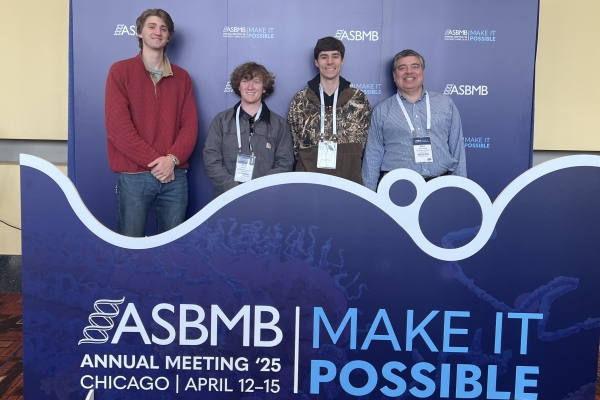 Shortly thereafter, McGavacks Professor of Biology and Director of Undergraduate Research and Creative Activity Michael Wolyniak accompanied John Hurt ’26, Garrett Regan ’25, and Ethan Currin ’25 to the American Society for Biochemistry and Molecular Biology (ASBMB) annual meeting in Chicago.
Shortly thereafter, McGavacks Professor of Biology and Director of Undergraduate Research and Creative Activity Michael Wolyniak accompanied John Hurt ’26, Garrett Regan ’25, and Ethan Currin ’25 to the American Society for Biochemistry and Molecular Biology (ASBMB) annual meeting in Chicago.
At the annual meeting, John and Garrett shared ongoing research from the lab of Elliott Assistant Professor of Chemistry Tim Reichart, which focused on the structural dynamics of the SARS-CoV-2 spike protein. Meanwhile, Ethan presented collaborative work conducted with Dr. Wolyniak and Dr. Louis Roberts of Worcester Polytechnic Institute on the activation of malate dehydrogenase in budding yeast.
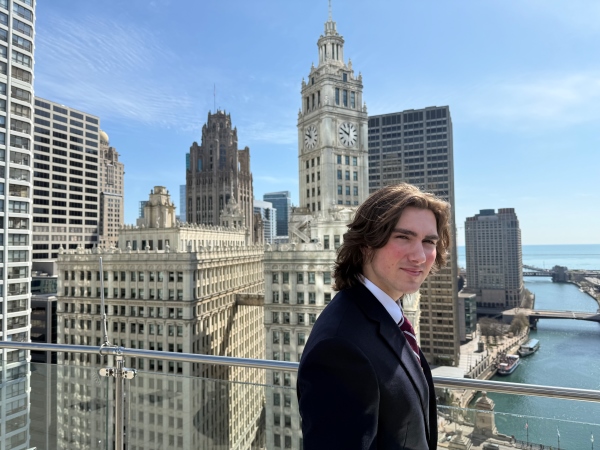 As April drew to a close, Baylor Jenkins ’26 attended the American Association for Cancer Research (AACR) annual meeting in Chicago to present research on mouse melanoma conducted in the lab of Trinkle Professor of Biology Kristian Hargadon ’01.
As April drew to a close, Baylor Jenkins ’26 attended the American Association for Cancer Research (AACR) annual meeting in Chicago to present research on mouse melanoma conducted in the lab of Trinkle Professor of Biology Kristian Hargadon ’01.
“The first day of the conference was the undergraduate student poster competition, where hundreds of students presented their own research,” Baylor says. “Just as was echoed throughout the main meeting, attendees came not only from across the United States but from all over the world. I had lunch next to students from Pakistan, Germany, Japan, and various American institutions.
“The second day was the main meeting, with tables and booths set up by science organizations from around the globe. Each booth featured staff, free gifts, informational flyers, tech demos, and more. Companies like Johnson & Johnson, Moderna, Pfizer, InduPro Inc., AstraZeneca, Novartis, and many others were represented. When I presented, many were surprised and impressed to see an undergraduate among them. Across from me was a doctor from Vienna; to his right and left were a postgraduate from Duke and a doctor from Oxford. Next to me was a doctor from Dublin and a postdoctoral researcher from Dartmouth. I received many thoughtful, in-depth questions about my research from doctors worldwide, often requiring me to speculate thoughtfully on complex topics.”
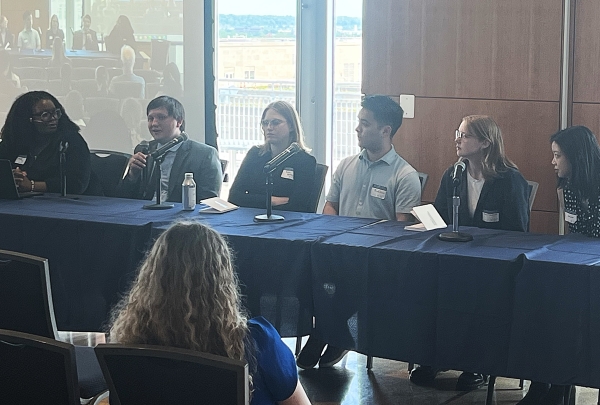 Concluding in early May, Wolyniak and Matthew Miscikowski ’26 attended the Student Journal Symposium for Literary and Research Publications held in Washington, D.C.
Concluding in early May, Wolyniak and Matthew Miscikowski ’26 attended the Student Journal Symposium for Literary and Research Publications held in Washington, D.C.
Matthew, editor-in-chief of The Hampden-Sydney Journal of the Sciences, took part in a panel titled “Navigating AI in Student Journals” alongside student editors from George Washington University, Georgetown University, and Boston University. The symposium, sponsored by the graduate program in publishing at George Washington University, brought together student leaders from 36 undergraduate and graduate journals representing 28 colleges and universities across the United States, Canada, and the United Kingdom. Topics included sustaining a successful journal, building collaborative ties across academic disciplines, and using journals to enhance student research programs.
With the support of our committed faculty, our students are not only presenting their research but also growing into leaders ready to make a meaningful impact. Thanks to the diverse opportunities these conferences provide, our students are well prepared to tackle future challenges, collaborate across disciplines, and contribute positively to their fields and communities.